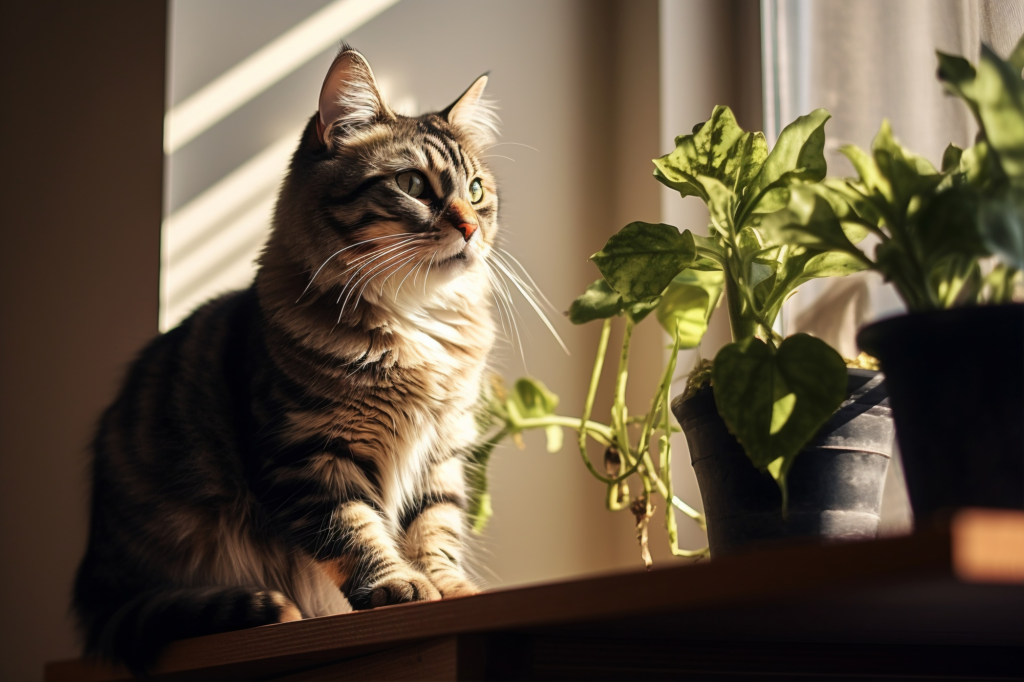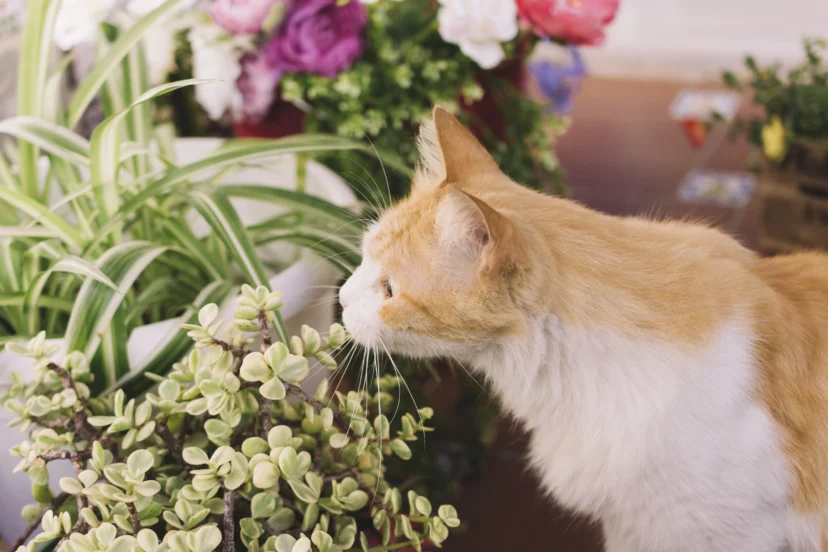Are Air Plants Safe for Curious Cats?
For cat owners who appreciate the beauty of houseplants, a common concern arises: are these new additions safe for our feline friends? Are air plants toxic to cats? No! Actually, the good news is that air plants can be a fantastic solution!
Unlike many popular houseplants, which can be toxic if ingested by curious cats, air plants are entirely non-toxic. Therefore, safe for your beloved curious cat.
Air Plants Are The Cat-Friendly Choice
Air houseplants, also known as Tillandsia, are unique because they don’t need soil to grow! They absorb water and nutrients from the air. This makes them a great choice for cat owners because many common houseplants can be poisonous to furry friends. But this one is totally non toxic.
Why Air Plants are Different from Toxic Plants
Many houseplants we know, like lilies and tulips, have poisons in them that can be very dangerous for cats if they eat them. Cats can get really sick, throwing up, having diarrhea, or even worse things happening to their kidneys.
Air houseplants, on the other hand, are entirely safe for cats to be around. No more worries! You can relax knowing your furry friend can explore your home freely without the risk of accidental poisoning from curious nibbling on your houseplants.

Essential Oils and Air Plants Are Safe for Cats
Some people like to use essential oils with air purifying plants for the way they smell or because they think the oils might help the plants. While some essential oils can be harmful to cats, the air purifying plants themselves are still safe for your feline friend.
If you do want to use essential oils, be sure to check on the specific oil first to see if it’s safe for cats. You might be better off just skipping the oils altogether to make sure both your cat and your air purifying plants are happy and healthy.
Other Safe Plant Options for Cat Owners
While air houseplants are a fantastic choice, there are other cat-friendly plants you can explore to create a vibrant and fun indoor jungle. Here are some popular options that won’t hurt your cat:
- Spider Plants: These droopy plants are known for cleaning the air and being easy to care for. They’re also safe for cats.
- Ferns: These leafy plants love humid places and add a touch of lushness to your home. Many fern varieties are safe for cats.
- Certain Orchid Varieties: Orchids, with their pretty flowers, are a popular choice for many people. Some orchid varieties, like Phalaenopsis orchids, are safe for cats to be around. Just remember to check on the specific type of orchid before bringing it home.
By adding a variety of cat-safe plants alongside your air houseplants, you can create a beautiful and enriching environment for both you and your feline companion.

Keeping Air Plants Out of Reach
Even though air purifying plants are safe to eat, it’s still a good idea to keep them out of your cat’s reach. Cats might chew on the leaves out of curiosity, which could damage the plant. Some air purifying plants might also be displayed with moss, which can be a choking hazard for cats. Here are some ideas for displaying air purifying plants safely:
- Hanging terrariums: These are glass containers that hang from the ceiling or wall. They’re a beautiful way to show off your air purifying plants while keeping them safely out of paw-reach.
- High shelves: Putting your air purifying plants on high shelves is another option to keep curious cats away.
- Living walls: These vertical gardens are a stylish and space-saving way to display air purifying plants while keeping them out of reach of your feline friend.
Air Plants and Other Safe Plants from the Bromeliad Family
Air plants belong to the bromeliad family. Many other bromeliads, like some bromeliad flowers, are also safe for cats. You may also opt for other plants like Bamboo Palm, Boston Fern and Spider plant, as these are also non toxic.
Chicken Wire Hack (Optional)
Here’s a bonus tip! Some people use chicken wire as a creative way to create a barrier around their air plants. This allows them to display the plants on lower shelves or tables without worrying about their cat reaching them. Moreso, if these are the plants toxic to cats.

A Safe and Happy Home for Both Cats and Air Plants
The most important thing is to create a safe and happy home for both your feline friend and your air plants. By keeping your air plants out of reach and choosing cat-safe plants, you can have the best of both worlds!
Perhaps, make a hanging terrarium or put your plants on a high shelf. Especially so if you have new plants and are still uncertain whether it is safe for your curious cat.
Signs a Cat Might Have Eaten a Plant
Even with cat-safe plants like air plants, it’s always a good idea to be aware of signs that your cat might have eaten a plant. Here’s what to watch out for:
- Throwing Up: This is a common sign of tummy trouble, which can happen if your cat eats something it shouldn’t.
- Diarrhea: Similar to throwing up, diarrhea can mean your cat’s stomach is upset from plant stuff.
- Not Wanting to Eat: If your cat suddenly loses interest in food, it could be a sign they don’t feel well, maybe from eating a plant.
- Acting Sleepy: A noticeable decrease in your cat’s energy levels could be a cause for concern.
If you notice any of these signs after your cat has been around plants, it’s best to see your vet right away. Getting help early can prevent bigger problems.
Other Concerns with Air Plants and Cats
While air plants themselves are safe to eat, there are a couple other things to keep in mind:
- Moss: Remember how we talked about some air plants being displayed with moss? Moss can be a choking hazard for cats, so keep an eye on your furry friend, especially if they like to chew on everything. If your cat is a nibbler, consider displaying your air plants in a different way.
- Keeping an Eye on Your Cat: Even with safe plants, it’s always a good idea to watch your cat around any houseplants, especially when they’re new. This way you can stop any curious chewing and make sure your cat isn’t eating too much of the plant.

Keeping Your Cat and Air Plants Happy
There are plenty of ways to ensure your cat’s safety while enjoying air plants in your home. Here are some tips:
- Explore Different Air Plant Types: Tillandsia ionantha is a popular and safe choice for cats. It comes in various shapes and colors, so you can find ones you like. There are spiky ones called Ionantha Fuego and silvery ones called Ionantha Scaposa.
Researching different Tillandsia varieties can help you find air plants that complement your décor and provide visual interest for both you and your cat (from a safe distance, of course).
- Scratching Posts for the Win: Cats have a natural instinct to scratch. Offering your cat plenty of scratching posts in various locations around the house can help deter them from using your air plants as a scratching surface. Choose scratching posts made from materials your cat enjoys, like sisal or cardboard.
- Switch Up Your Air Plant Displays: Cats can get bored easily. Regularly rotating the placement of your air plants can keep your feline friend curious without giving them the opportunity to get too close and potentially damage the plants.
The Joy of Air Plants
Air purifying plants are a beautiful and low-maintenance addition to any home. They come in a wide variety of shapes, sizes, and colors, offering endless possibilities for creative displays. Additionally, air houseplants require minimal care, needing only occasional watering and bright, indirect sunlight.
Most importantly, air houseplants are entirely safe for cats, making them a fantastic choice for pet owners. With a little planning and these helpful tips, you can create a harmonious living space that caters to both your love for greenery and your feline companion’s safety.
So, breathe easy, decorate with air houseplants, and enjoy the beauty and serenity they bring to your home! Choose no more, both your plants and furry friends can stay at your house together, without the worries of it being toxic to cats.




